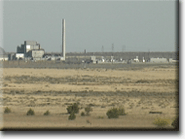2006
Uranium-233 in the Hanford Reach Riverbed (1.51 MB)
Since 1999, TRAC has surveyed artificial radioactivity in the sediments under the Hanford Reach of the Columbia River. Based on TRAC's accumulating evidence of uranium-233 waste in the riverbed, the Washington State Ecology Department jointly sampled riverbed sediments with TRAC on Sept. 23, 2004. TRAC reviewed Ecology's data and confirmed uranium-233 waste in the sediment samples. This report outlines the sampling process, laboratory data, and TRAC's review.
2005
Hanford State of the Site Meeting Comments,
Uranium-233
December 2005 letter from Jay Manning, Ecology Director, regarding TRAC's State of the Site comments.
Radioactive Bioaccumulation in Clams along the Hanford Reach (523 KB)
In September 2004, TRAC began a radiological study of Hanford's impact on riverbed water and Asian clams at six locations along the Hanford Reach. This study is the first report of radioactive radium from Hanford's 300 Area contaminating aquatic biota in the Columbia River.
2003
Trouble in the Columbia Riverbed: increasing radioactivity under the Hanford Reach (1.04 MB)
"Trouble in the Columbia Riverbed" outlines TRAC’s year 2002 radiological survey of the Hanford Reach riverbed. That survey found that artificial radium-225 (Ra-225) is dissolving into the riverbed water from Hanford Reach sediments. Ra-225 is created by the radioactive decay of artificial uranium-233, a material produced at Hanford during the Cold War and used for battlefield nuclear weapons.
TRAC has identified three separate plumes of Ra-225 in riverbed water, downstream of three barge-and-tug terminals that had supported wartime operations at Hanford. That radiation is increasing. Unless remedial action is taken, the Ra-225 activity will likely increase more than a hundred fold, over the next several thousand years. Unfortunately, there are already early warning signs of biological trouble in the Columbia riverbed.
Uranium-233 Detected in Hanford Reach Sediments
(37 KB)
This data report, including methods and results, is the first report of Hanford's uranium-233 in the Hanford Reach riverbed.
2002
Hanford Radioactivity in Salmon Spawning Grounds (2.52 MB)
Sixty percent of the Columbia Riverbed where important salmon stocks spawn is contaminated with previously unreported radioactive wastes from Old nuclear weapons production at Hanford Site. This radioactive contamination evidently results from the disposal of solid radioactive waste directly into the Columbia River.
The magnitude of the long-term radiological threat to the salmon stocks remains undetermined.
Public oversight of Hanford needs to be re-invented if management of Hanford Site is to become realistic and clean-up is to become effective and meaningful for the long term.
Questions and Answers on Uranium-233 at Hanford
An overview of the thorium-to-uranium process at the Hanford nuclear site.
Report of Hanford Site Access of 11/12/02 (80.3 KB)
TRAC's data from on-site sampling at Hanford shows cleanup of 300 Area has failed.
1987
Accounting a Few Radionuclides from Hanford Groundwater (380 KB)
Hanford Reservation is a nuclear weapons production facility operated by the U.S. Department of Energy (USDOE). Hanford also produces, disposes of, and manages nuclear wastes.
A very small fraction of these wastes enter the Columbia River.
1986
Summer 1986 Data Report (210 KB)
HRP sampled Columbia River Spring #8-12 near the 1301N/1325N cooling water disposal trenches. Nitrate concentration in the spring water and environmental radiation there were far above normal suggesting a possible leak of undecayed N-Reactor and fuel cooling water into the river. Such a leak would be dominated by short-lived radionuclides.
Spring 1986 Data Report (270 KB)
This historic report (published under TRAC’s founding name, the Hanford Reach Project) shows the travel time from central Hanford waste disposal areas to the Columbia River are 3 - 5 years. This study disproved the Department of Energy's claim of a travel time minimum of at least 30 years. This report was reviewed and confirmed by the U.S. Geological Survey. [“Subsurface Transport of Radionuclides in Shallow Deposits of the Hanford Nuclear Reservation, Washington – Review of Selected Previous Work and Suggestions for Further Study,” Open-File Report 87-222, Tacoma, Washington (1987)]
Technical Basis of the Channel Theory (133 KB)
Since 1960, geologists have known that several old Columbia River channels cut the Ringold formation at Hanford. These channels were filled with Pasco gravels as the glaciers receded. Data from Hanford wells showed one such channel at the 200 East Area and another at the old Hanford Townsite. We propose that these are one and the same channel which forms the major groundwater feature at Hanford.

